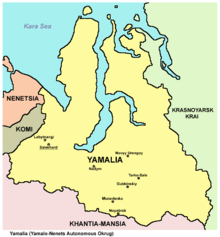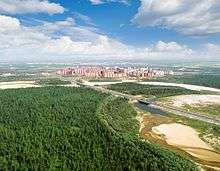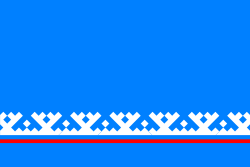Yamalo-Nenets Autonomous Okrug
Yamalo-Nenets Autonomous Okrug (Russian: Яма́ло-Не́нецкий автоно́мный о́круг, Yamalo-Nenetsky Avtonomny Okrug; Nenets: Ямалы-Ненёцие автономной ӈокрук, Yamaly-Nenyotsiye avtonomnoj ŋokruk, ЯНАО (YaNAO)) is a federal subject of Russia (an autonomous okrug of Tyumen Oblast). Its administrative center is the town of Salekhard, and its largest city is Noyabrsk. Its population was counted to be 522,904 in the 2010 Census.[8]
Yamalo-Nenets Autonomous Okrug | |
|---|---|
| Ямало-Ненецкий автономный округ | |
 Coat of arms | |
| Anthem: Anthem of Yamalo-Nenets Autonomous Okrug | |
.svg.png) | |
| Coordinates: 67°15′N 74°40′E | |
| Country | Russia |
| Federal district | Ural[2] |
| Economic region | West Siberian[3] |
| Established | December 10, 1930[4] |
| Administrative center | Salekhard |
| Government | |
| • Body | Legislative Assembly[5] |
| • Governor[5] | Dmitry Artyukhov[6] |
| Area | |
| • Total | 750,300 km2 (289,700 sq mi) |
| Area rank | 6th |
| Population (2010 Census)[8] | |
| • Total | 522,904 |
| • Estimate (2018)[9] | 538,547 (+3%) |
| • Rank | 71st |
| • Density | 0.70/km2 (1.8/sq mi) |
| • Urban | 84.7% |
| • Rural | 15.3% |
| Time zone | UTC+5 (MSK+2 |
| ISO 3166 code | RU-YAN |
| License plates | 89 |
| OKTMO ID | 71900000 |
| Official languages | Russian[11] |
| Website | http://правительство.янао.рф |
Geography and natural history

The Nenets people are an indigenous tribe who have long survived in this region. Their prehistoric life involved subsistence hunting and gathering, including the taking of polar bears; the practice of hunting polar bears (Ursus maritimus) continues up to the present time.[12]
Yamalo-Nenetsky Avtonomny Okrug is traversed by the northeasterly line of equal latitude and longitude, that is, at the point 70°N and 70°E, with equal degrees.
The area consists of arctic tundra and taiga, with three large peninsulas - the Yamal Peninsula, Taz Peninsula and the Gyda Peninsula (itself containing the Yavay Peninsula and Mamonta Peninsula).
The Ob River flows through Yamalo-Nenets Autonomous Okrug to the Kara Sea via the Gulf of Ob, which dominates the geography of the Okrug (together with its two sub-bays, the Taz Estuary and Khalmyer Bay.[13][14][15]
A number of islands are off the okrug's coast - from west to east, the main ones are Torasovey Island, Bolotnyy Island, Litke Island, Sharapovy Koshki Islands, Bely Island, Shokalsky Island, Petsovyye Islands, Proklyatyye Islands, Oleny Island, and Vilkitsky Island.
History
On December 10, 1930, Yamal (Nenets) National Okrug (Ямальский (Ненецкий) национальный округ) was formed based on Ural Oblast.
Administrative divisions
Demographics
Population: 522,904 (2010 Census);[8] 507,006 (2002 Census);[16] 486,164 (1989 Census).[17]

Vital statistics
| Average population (x 1000) | Live births | Deaths | Natural change | Crude birth rate (per 1000) | Crude death rate (per 1000) | Natural change (per 1000) | |
|---|---|---|---|---|---|---|---|
| 1970 | 84 | 1,683 | 879 | 804 | 20.0 | 10.5 | 9.6 |
| 1975 | 127 | 2,307 | 819 | 1,488 | 18.2 | 6.4 | 11.7 |
| 1980 | 194 | 3,347 | 1,178 | 2,169 | 17.3 | 6.1 | 11.2 |
| 1985 | 374 | 7,838 | 1,555 | 6,283 | 21.0 | 4.2 | 16.8 |
| 1990 | 489 | 8 032 | 1 631 | 6 401 | 16.4 | 3.3 | 13.1 |
| 1991 | 483 | 7,121 | 1,623 | 5,498 | 14.7 | 3.4 | 11.4 |
| 1992 | 470 | 6,123 | 2,108 | 4,015 | 13.0 | 4.5 | 8.5 |
| 1993 | 466 | 5,697 | 2,764 | 2,933 | 12.2 | 5.9 | 6.3 |
| 1994 | 473 | 6,274 | 2,998 | 3,276 | 13.3 | 6.3 | 6.9 |
| 1995 | 483 | 6,337 | 3,107 | 3,230 | 13.1 | 6.4 | 6.7 |
| 1996 | 489 | 6,241 | 3,004 | 3,237 | 12.8 | 6.1 | 6.6 |
| 1997 | 495 | 6,208 | 2,715 | 3,493 | 12.5 | 5.5 | 7.1 |
| 1998 | 498 | 6,395 | 2,544 | 3,851 | 12.8 | 5.1 | 7.7 |
| 1999 | 498 | 6,071 | 2,608 | 3,463 | 12.2 | 5.2 | 7.0 |
| 2000 | 497 | 5,839 | 2,763 | 3,076 | 11.7 | 5.6 | 6.2 |
| 2001 | 501 | 6,388 | 3,057 | 3,331 | 12.8 | 6.1 | 6.7 |
| 2002 | 506 | 6,635 | 2,934 | 3,701 | 13.1 | 5.8 | 7.3 |
| 2003 | 510 | 7,163 | 3,093 | 4,070 | 14.1 | 6.1 | 8.0 |
| 2004 | 511 | 7,264 | 2,975 | 4,289 | 14.2 | 5.8 | 8.4 |
| 2005 | 512 | 7,148 | 3,099 | 4,049 | 14.0 | 6.0 | 7.9 |
| 2006 | 513 | 7,036 | 3,000 | 4,036 | 13.7 | 5.8 | 7.9 |
| 2007 | 515 | 7,700 | 2,937 | 4,763 | 14.9 | 5.7 | 9.2 |
| 2008 | 517 | 7,892 | 2,959 | 4,933 | 15.3 | 5.7 | 9.5 |
| 2009 | 519 | 8,216 | 2,924 | 5,292 | 15.8 | 5.6 | 10.2 |
| 2010 | 522 | 8,263 | 2,873 | 5,390 | 15.8 | 5.5 | 10.3 |
Regional demographics

Source[18]
| Raion | Pp (2007) | Births | Deaths | Growth | BR | DR | NGR |
|---|---|---|---|---|---|---|---|
| Yamalo-Nenets Autonomous Okrug | 538,600 | 5,814 | 2,202 | 3,612 | 14.39 | 5.45 | 0.89% |
| Salekhard | 40,500 | 499 | 256 | 243 | 16.43 | 8.43 | 0.80% |
| Gubkinsky | 22,300 | 263 | 71 | 192 | 15.72 | 4.25 | 1.15% |
| Labytnangi | 27,700 | 333 | 212 | 121 | 16.03 | 10.20 | 0.58% |
| Muravlenko | 37,000 | 361 | 104 | 257 | 13.01 | 3.75 | 0.93% |
| Nadym | 48,500 | 443 | 197 | 246 | 12.18 | 5.42 | 0.68% |
| Novy Urengoy | 117,000 | 1,122 | 334 | 788 | 12.79 | 3.81 | 0.90% |
| Noyabrsk | 109,900 | 1,029 | 384 | 645 | 12.48 | 4.66 | 0.78% |
| Krasnoselkupsky | 6,200 | 99 | 41 | 58 | 21.29 | 8.82 | 1.25% |
| Nadymsky | 21,300 | 221 | 67 | 154 | 13.83 | 4.19 | 0.96% |
| Priuralsky | 15,300 | 179 | 72 | 107 | 15.60 | 6.27 | 0.93% |
| Purovsky | 49,900 | 548 | 195 | 353 | 14.64 | 5.21 | 0.94% |
| Tazovsky | 17,200 | 268 | 92 | 176 | 20.78 | 7.13 | 1.36% |
| Shuryshkarsky | 9,900 | 144 | 69 | 75 | 19.39 | 9.29 | 1.01% |
| Yamalsky | 15,900 | 305 | 108 | 197 | 25.58 | 9.06 | 1.65% |
Ethnic groups
The Nenets make up 5.9% of the population, preceded by ethnic Russians (61.7%) and Ukrainians (9.7%), followed by Tatars (5.6%). Other prominent ethnic groups include Belarusians (1.3%), Khants (1.9%), Azerbaijanis (1.8%), Bashkirs (1.7%), Komi (1%), and Moldovans (0.9%) (all figures are from the 2010 Census).[8] Due to the area's oil and natural gas wealth, it is one of the few places in Russia where the ethnic Russian population is growing.
| Ethnic group |
1939 Census | 1959 Census | 1970 Census | 1979 Census | 1989 Census | 2002 Census | 2010 Census1 | |||||||||
|---|---|---|---|---|---|---|---|---|---|---|---|---|---|---|---|---|
| Number | % | Number | % | Number | % | Number | % | Number | % | Number | % | Number | % | |||
| Nenets | 13,454 | 29.3% | 13,977 | 22.4% | 17,538 | 21.9% | 17,404 | 11.0% | 20,917 | 4.2% | 26,435 | 5.2% | 29,772 | 5.9% | ||
| Khants | 5,367 | 11.7% | 5,519 | 8.9% | 6,513 | 8.1% | 6,466 | 4.1% | 7,247 | 1.5% | 8,760 | 1.7% | 9,489 | 1.9% | ||
| Komi | 4,722 | 10.3% | 4,866 | 7.8% | 5,445 | 6.8% | 5,642 | 3.6% | 6,000 | 1.2% | 6,177 | 1.2% | 5,141 | 1.0% | ||
| Selkups | 87 | 0.2% | 1,245 | 2.0% | 1,710 | 2.1% | 1,611 | 1.0% | 1,530 | 0.3% | 1,797 | 0.4% | 1,988 | 0.4% | ||
| Russians | 19,308 | 42.1% | 27,789 | 44.6% | 37,518 | 46.9% | 93,750 | 59.0% | 292,808 | 59.2% | 298,359 | 58.8% | 312,019 | 61.7% | ||
| Ukrainians | 395 | 0.9% | 1,921 | 3.1% | 3,026 | 3.8% | 15,721 | 9.9% | 85,022 | 17.2% | 66,080 | 13.0% | 48,985 | 9.7% | ||
| Tatars | 1,636 | 3.6% | 3,952 | 6.3% | 4,653 | 5.8% | 8,556 | 5.4% | 26,431 | 5.3% | 27,734 | 5.5% | 28,509 | 5.6% | ||
| Others | 871 | 1.9% | 3,065 | 4.9% | 3,574 | 4.5% | 9,694 | 6.1% | 54,889 | 11.1% | 71,664 | 14.1% | 74,625 | 14.3% | ||
| 1 17,517 people were registered from administrative databases, and could not declare an ethnicity. The proportion of ethnicities in this group is estimated to be the same as that of the declared group.[19] | ||||||||||||||||
Religion
According to a 2012 survey[20] 42.2% of the population of Yamalia adhere to the Russian Orthodox Church, 14% are unaffiliated generic Christians, 1% are believers in Orthodox Christianity who do not belong to any church, 1% are members of the Slavic neopaganism (Rodnovery) or practitioners of local shamanic religions, and 1% are members of Protestant churches; Muslims, mostly Caucasian peoples and Tatars, make up 18% of the total population. In addition, 14% of the population declare to be "spiritual but not religious", 8% are atheist, and 0.8% follow other religions or did not give an answer to the question.[20]
Economy
Yamalo-Nenetsky Avtonomny Okrug is Russia's most important source of natural gas, with more than 90% of Russia's natural gas being produced there. The region also accounts for 12% of Russia's oil production.[22] The region is the most importance to Russia's largest company Gazprom, whose main production fields are located there. Novatek – the country's second-largest gas producer – is also active in the region, with its headquarteres located in Tarko-Sale.
Notable people
- Anastasia Lapsui (b. 1944), Nenets film director, screenwriter, radio journalist
References
Notes
- Law #119-ZAO
- Президент Российской Федерации. Указ №849 от 13 мая 2000 г. «О полномочном представителе Президента Российской Федерации в федеральном округе». Вступил в силу 13 мая 2000 г. Опубликован: "Собрание законодательства РФ", No. 20, ст. 2112, 15 мая 2000 г. (President of the Russian Federation. Decree #849 of May 13, 2000 On the Plenipotentiary Representative of the President of the Russian Federation in a Federal District. Effective as of May 13, 2000.).
- Госстандарт Российской Федерации. №ОК 024-95 27 декабря 1995 г. «Общероссийский классификатор экономических регионов. 2. Экономические районы», в ред. Изменения №5/2001 ОКЭР. (Gosstandart of the Russian Federation. #OK 024-95 December 27, 1995 Russian Classification of Economic Regions. 2. Economic Regions, as amended by the Amendment #5/2001 OKER. ).
- Charter of Yamalo-Nenets Autonomous Okrug, Article 1
- Charter of Yamalo-Nenets Autonomous Okrug, Article 11
- Official website of Yamalo-Nenets Autonomous Okrug. Dmitry Nikolayevich Kobylkin, Governor of Yamalo-Nenets Autonomous Okrug (in Russian)
- Федеральная служба государственной статистики (Federal State Statistics Service) (May 21, 2004). "Территория, число районов, населённых пунктов и сельских администраций по субъектам Российской Федерации (Territory, Number of Districts, Inhabited Localities, and Rural Administration by Federal Subjects of the Russian Federation)". Всероссийская перепись населения 2002 года (All-Russia Population Census of 2002) (in Russian). Federal State Statistics Service. Retrieved November 1, 2011.
- Russian Federal State Statistics Service (2011). "Всероссийская перепись населения 2010 года. Том 1" [2010 All-Russian Population Census, vol. 1]. Всероссийская перепись населения 2010 года [2010 All-Russia Population Census] (in Russian). Federal State Statistics Service.
- "26. Численность постоянного населения Российской Федерации по муниципальным образованиям на 1 января 2018 года". Federal State Statistics Service. Retrieved January 23, 2019.
- "Об исчислении времени". Официальный интернет-портал правовой информации (in Russian). June 3, 2011. Retrieved January 19, 2019.
- Official throughout the Russian Federation according to Article 68.1 of the Constitution of Russia.
- C. Michael Hogan (2008) Polar Bear: Ursus maritimus, Globaltwitcher.com, ed. Nicklas Stromberg
- Regional Index: Regional Index, accessdate: May 5, 2017
- Britannica: ob, accessdate: May 5, 2017
- Yamalo-Nenets region, Russia facts, resources, climate, photos: Yamalo-Nenets region, Russia facts, resources, climate, photos, accessdate: May 5, 2017
- Russian Federal State Statistics Service (May 21, 2004). "Численность населения России, субъектов Российской Федерации в составе федеральных округов, районов, городских поселений, сельских населённых пунктов – районных центров и сельских населённых пунктов с населением 3 тысячи и более человек" [Population of Russia, Its Federal Districts, Federal Subjects, Districts, Urban Localities, Rural Localities—Administrative Centers, and Rural Localities with Population of Over 3,000] (XLS). Всероссийская перепись населения 2002 года [All-Russia Population Census of 2002] (in Russian).
- "Всесоюзная перепись населения 1989 г. Численность наличного населения союзных и автономных республик, автономных областей и округов, краёв, областей, районов, городских поселений и сёл-райцентров" [All Union Population Census of 1989: Present Population of Union and Autonomous Republics, Autonomous Oblasts and Okrugs, Krais, Oblasts, Districts, Urban Settlements, and Villages Serving as District Administrative Centers]. Всесоюзная перепись населения 1989 года [All-Union Population Census of 1989] (in Russian). Институт демографии Национального исследовательского университета: Высшая школа экономики [Institute of Demography at the National Research University: Higher School of Economics]. 1989 – via Demoscope Weekly.
- http://www.oblstat.tmn.ru/statinfo\act\dwiz.htm for 2008 (January-October)
- Перепись-2010: русских становится больше. Perepis-2010.ru (2011-12-19). Retrieved on 2013-08-20.
- "Arena: Atlas of Religions and Nationalities in Russia". Sreda, 2012.
- 2012 Arena Atlas Religion Maps. "Ogonek", № 34 (5243), 27/08/2012. Retrieved 21/04/2017. Archived.
- "Yamalo-Nenets Autonomous Area". Kommersant. March 5, 2004. Retrieved August 26, 2009.
Sources
- Законодательное Собрание Ямало-Ненецкого автономного округа. Закон №119-ЗАО от 17 ноября 2010 г. «О гимне Ямало-Ненецкого автономного округа». Вступил в силу со дня официального опубликования (20 ноября 2010 г.). Опубликован: "Красный Север", спецвыпуск №147/1, 20 ноября 2010 г. (Legislative Assembly of Yamalo-Nenets Autonomous Okrug. Law #119-ZAO of November 17, 2010 On the Anthem of Yamalo-Nenets Autonomous Okrug. Effective as of the day of the official publication (November 20, 2010).).
- Государственная Дума Ямало-Ненецкого автономного округа. №56-ЗАО 28 декабря 1998 г. «Устав (Основной Закон) Ямало-Ненецкого автономного округа», в ред. Закона №140-ЗАО от 21 декабря 2015 г. «О внесении изменений в Устав (Основной Закон) Ямало-Ненецкого автономного округа». Вступил в силу 15 января 1999 г. Опубликован: "Красный Север", 15 января 1999 г. (State Duma of Yamalo-Nenets Autonomous Okrug. #56-ZAO December 28, 1998 Charter (Basic Law) of Yamalo-Nenets Autonomous Okrug, as amended by the Law #140-ZAO of December 21, 2015 An Amending the Charter (Basic Law) of Yamalo-Nenets Autonomous Okrug. Effective as of January 15, 1999.).
External links
| Wikimedia Commons has media related to Yamalo-Nenets Autonomous Okrug. |

.jpg)
.jpg)